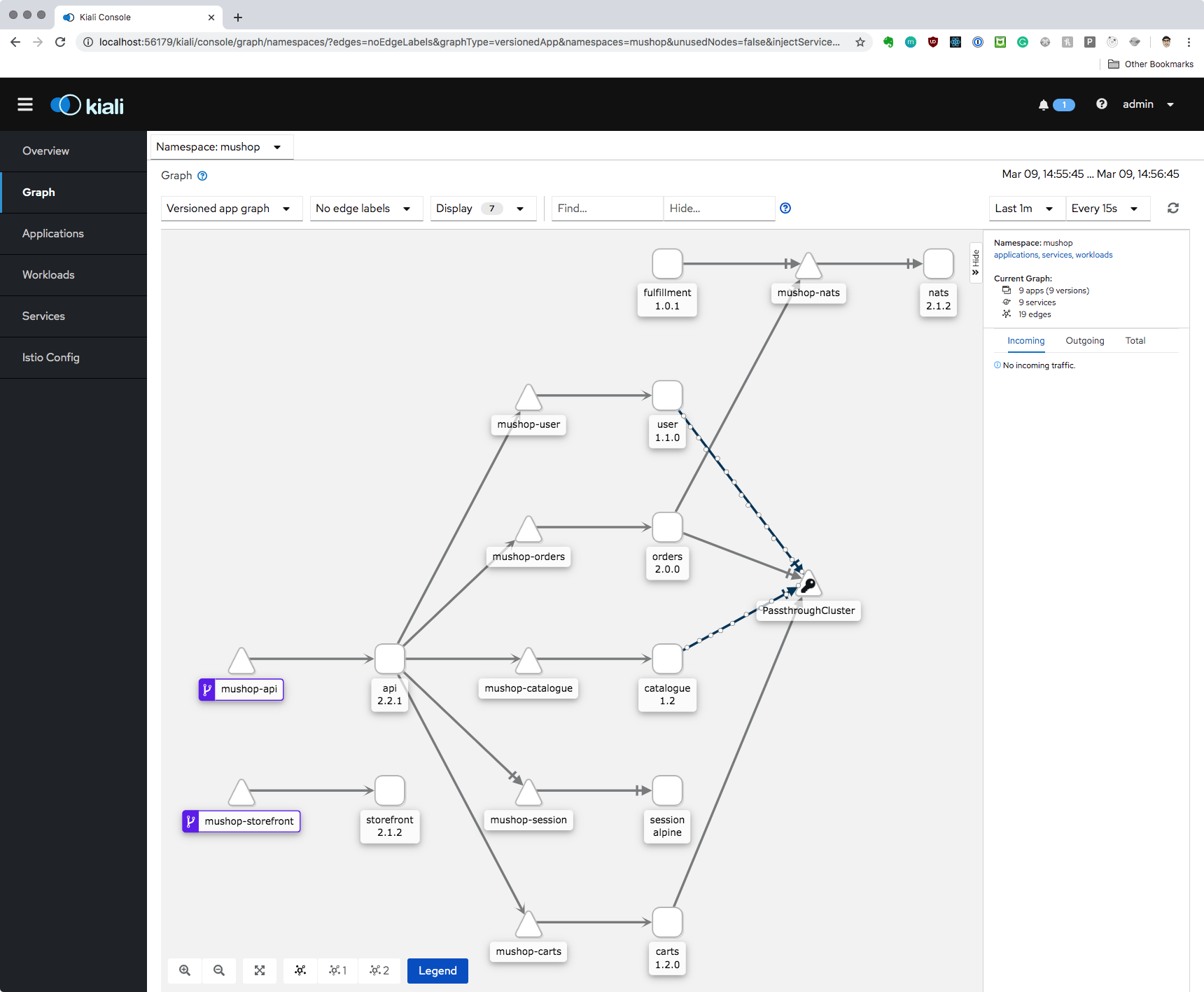Istio Service Mesh
In this section you can install and configure Istio service mesh. The mesh needs to be installed before you deploy Mushop for the service mesh proxies to get injected next to each Mushop service.
These sidecar proxies intercept the traffic between services and collect data on all requests as well as allow scenarios such as traffic routing and failure injection.
Download and install Istio
-
Download the latest Istio release (
1.4.6at the time of writing this):curl -L https://istio.io/downloadIstio | sh - -
Go to the
istio-1.4.6folder and add theistioctlto your path:export PATH=$PWD/bin:$PATHBefore you continue with Istio installation, run the
verify-installcommand to make sure Istio can be installed on your cluster:$ istioctl verify-install ... Install Pre-Check passed! The cluster is ready for Istio installation.If you get the
Pre-Check passedmessage, you can continue. -
Install the Istio
demoprofile:istioctl manifest apply --set profile=demoThe output of the above command should look something like this:
$ istioctl manifest apply --set profile=demo - Applying manifest for component Base... ✔ Finished applying manifest for component Base. - Applying manifest for component EgressGateway... - Applying manifest for component Prometheus... - Applying manifest for component Pilot... - Applying manifest for component Tracing... - Applying manifest for component Citadel... - Applying manifest for component Injector... - Applying manifest for component Galley... - Applying manifest for component Kiali... - Applying manifest for component IngressGateway... - Applying manifest for component Policy... - Applying manifest for component Telemetry... - Applying manifest for component Grafana... ✔ Finished applying manifest for component Galley. ✔ Finished applying manifest for component Kiali. ✔ Finished applying manifest for component Injector. ✔ Finished applying manifest for component Prometheus. ✔ Finished applying manifest for component Citadel. ✔ Finished applying manifest for component Pilot. ✔ Finished applying manifest for component Policy. ✔ Finished applying manifest for component IngressGateway. ✔ Finished applying manifest for component Tracing. ✔ Finished applying manifest for component EgressGateway. ✔ Finished applying manifest for component Telemetry. ✔ Finished applying manifest for component Grafana. ✔ Installation completeYou also need to run
kubectl get pods -n istio-systemand ensure all pods are in the running state (the value of theSTATUScolumn for each pod should beRunning)Before continuing with the Mushop deployment, you also need to label the
mushopnamespace in order for Istio to automatically inject the Envoy sidecar proxy next to each Mushop service. -
Create the
mushopnamespace:
kubectl create ns mushop
- Label the namespace with
istio-injection=enabled:
kubectl label namespace mushop istio-injection=enabled
- Follow the instructions for deploying Mushop.
Creating Istio resources
In order to configure the traffic routing and the ingress gateway, you will need to deploy a Gateway resource and a VirtualService resource.
-
Deploy a Gateway resource:
cat << EOF | kubectl apply -f - apiVersion: networking.istio.io/v1alpha3 kind: Gateway metadata: name: gateway namespace: mushop spec: selector: istio: ingressgateway servers: - port: number: 80 name: http protocol: HTTP hosts: - '*' EOF"apiVersion: networking.istio.io/v1alpha3 kind: Gateway metadata: name: gateway namespace: mushop spec: selector: istio: ingressgateway servers: - port: number: 80 name: http protocol: HTTP hosts: - '*'" | kubectl apply -f - -
Deploy a VirtualService:
cat <<EOF | kubectl apply -f - apiVersion: networking.istio.io/v1alpha3 kind: VirtualService metadata: name: edge namespace: mushop spec: hosts: - '*' gateways: - gateway http: - match: - uri: prefix: /api route: - destination: host: mushop-api.mushop.svc.cluster.local - match: - uri: prefix: /assets rewrite: uri: / route: - destination: host: mushop-assets.mushop.svc.cluster.local - route: - destination: host: mushop-storefront.mushop.svc.cluster.local port: number: 80 EOF"apiVersion: networking.istio.io/v1alpha3 kind: VirtualService metadata: name: edge namespace: mushop spec: hosts: - '*' gateways: - gateway http: - match: - uri: prefix: /api route: - destination: host: mushop-api.mushop.svc.cluster.local - match: - uri: prefix: /assets rewrite: uri: / route: - destination: host: mushop-assets.mushop.svc.cluster.local - route: - destination: host: mushop-storefront.mushop.svc.cluster.local port: number: 80" | kubectl apply -f - -
Open a browser with the
EXTERNAL-IPof the Instio ingress gateway:kubectl get svc istio-ingressgateway \ --namespace istio-systemLocating
EXTERNAL-IPfor Istio Ingress Gateway. NOTE this will be localhost on local clusters.
Kiali Dashboard
Kiali is a service mesh observability tool that allows you to understand the structure of your service mesh, visualize the service inside the mesh and provides the health of the mesh. Additionally, you can view detailed metrics using Grafana integration and distribute tracing with Jaeger integration.
-
From the terminal, open Kiali dashboard
istioctl dashboard kiali -
Click the Graph option from the sidebar.
-
From the dropdown select the mushop namespace.
-
You should see a service graph that looks similar to the figure below;

Cleanup
Uninstall Istio by passing the generated manifests into kubectl delete
istioctl manifest generate --set profile=demo | kubectl delete -f -